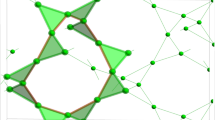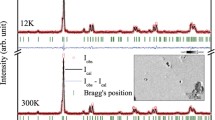Abstract
The classical ground states of the frustrated antiferromagnet gadolinium gallium garnet are studied in three distinct phases in a range of external magnetic fields. It is found that a simple optimization strategy based around Monte–Carlo simulated annealing is insufficient to correctly describe the disordered phases in reasonable time scales, and a rapid and reliable optimization scheme which is able to locate states of significantly lower energy is devised. In the zero-field phase the optimization scheme reproduces the long-range multipole order describing antiferromagnetic spin correlations around ten site rings, which has previously been inferred at finite temperatures from experimental neutron scattering data. In the intermediate field phase the simulated ground states are found to agree well with experimental neutron scattering data at the lowest temperatures, and it is shown that the multipole directors are also useful in understanding the spin structure in this phase.







Similar content being viewed by others
Data Availibility Statement
All data used in this study is available upon request to the authors.
Code Availability
Custom code in Matlab 2018 and Mathematica 11 written by the authors were used in this study. Code is available upon request to the authors.
References
L. Balents, Nature 464, 199 (2010)
J.S. Gardner, M.J.P. Gingras, J.E. Greedan, Rev. Mod. Phys. 82, 53 (2010)
P.P. Deen, O. Florea, E. Lhotel, H. Jacobsen, Phys. Rev. B 91(1), 014419 (2015)
A. Rousseau, J.M. Parent, J.A. Quilliam, Phys. Rev. B 96(6), 060411 (2017)
S. Hov, H. Bratsberg, A.T. Skjeltorp, J. Mag. Mag. Mat. 15–18, 455 (1980)
P. Schiffer, A.P. Ramirez, D.A. Huse, A.J. Valentino, Phys. Rev. Lett. 73(18), 2500 (1994)
P. Schiffer, A.P. Ramirez, D.A. Huse, P.L. Gammel, U. Yaron, D.J. Bishop, A.J. Valentino, Phys. Rev. Lett. 74(12), 2379 (1995)
O.A. Petrenko, G. Balakrishnan, D.M. Paul, M. Yethiraj, J. Klenke, Appl. Phys. A 74, S760 (2002)
O.A. Petrenko, G. Balakrishnan, D.M. Paul, M. Yethiraj, G.J. McIntyre, A.S. Wills, J. Phys: Conf. Ser. 145, 012026 (2009)
S.R. Dunsiger, J.S. Gardner, J. Chakhalian, A.L. Cornelius, M. Jaime, R.F. Kiefl, R. Movshovich, W.A. MacFarlane, R.I. Miller, J.E. Sonier, B.D. Gaulin, Phys. Rev. Lett. 85(16), 3504 (2000)
I.M. Marshall, S.J. Blundell, F.L. Pratt, A. Husmann, C.A. Steer, A.I. Coldea, W. Hayes, R.C.C. Ward, J. Phys.: Condens. Matter 14(6), 104 (2002)
J.A.M. Paddison, H. Jacobsen, O.A. Petrenko, M.T. Fernández-Diaz, P.P. Deen, A.L. Goodwin, Science 350(6257), 179 (2015)
H. Jacobsen, O. Florea, E. Lhotel, K. Lefmann, O.A. Petrenko, C.S. Knee, T. Seydel, P.F. Henry, R. Bewley, D. Voneshen, A. Wildes, G. Nilsen, P.P. Deen, Phys. Rev. B 104, 54440 (2021)
P.P. Deen, Front. Phys. 10, 868339 (2022)
N. d’Ambrumenil, O.A. Petrenko, H. Mutka, P.P. Deen, Phys. Rev. Lett. 114(22), 227203 (2015)
O.A. Petrenko, C. Ritter, M. Yethiraj, D.M. Paul, Phys. Rev. Lett. 80(20), 4570 (1998)
J. Overmeyer, Paramagnetic Resonance (Academic Press, New York, 1963), chap. 15
W.I. Kinney, W.P. Wolf, J. Appl. Phys. 50(3), 2115 (1979)
O.A. Petrenko, D.M. Paul, Phys. Rev. B 63(2), 024409 (2000)
M. Ancliff, V. Sachnev, N. d’Ambumenil, J. Phys.: Condens. Matter 33, 475801 (2021)
J. Jensen, A.R. Mackintosh, Rare Earth Magnetism: Structures and Excitations (Clarendon Press, Oxford, 1991)
J.A. Quilliam, S. Meng, H.A. Craig, L.R. Corruccini, G. Balakrishnan, O.A. Petrenko, A. Gomez, S.W. Kycia, M.J.P. Gingras, J.B. Kycia, Phys. Rev. B 87(17), 174421 (2013)
S.F. Edwards, P.W. Anderson, J. Phys. F: Met. Phys. 5(5), 965 (1975)
D. Sherrington, S. Kirkpatrick, Phys. Rev. Lett. 35, 1792 (1975)
S. Boettcher, A.G. Percus, Phys. Rev. Lett. 86(23), 5211 (2001)
S. Boettcher, Eur. Phys. J. B 74, 363 (2010)
M. Pelikan, H.G. Katzgraber, S. Kobe, GECCO’08: Proceedings of the 10th Annual Conference on Genetic and Evolutionary Computation pp. 447–454 (2008)
Acknowledgements
This research was supported by The Catholic University of Korea Research Fund, 2020.
Funding
M. Ancliff was supported by the Catholic University of Korea Research Fund 2020.
Author information
Authors and Affiliations
Corresponding author
Ethics declarations
Conflicts of interest
The authors declare that they have no conflict of interest.
Additional information
Publisher's Note
Springer Nature remains neutral with regard to jurisdictional claims in published maps and institutional affiliations.
The locally optimized simulated annealing algorithm
The locally optimized simulated annealing algorithm
The Locally Optimized Simulated Annealing algorithm combines an annealed Monte–Carlo simulation of the spins with controlled local optimization of selected spins for faster iterative improvement.
The energy change from the substitution of any spin, \({\textbf{S}}_i \rightarrow {\textbf{S}}_i^\textrm{new}\), is calculated by the Hamiltonian (1). For any given \({\textbf{S}}_i\), the spin substitution which minimizes the energy, \({\textbf{S}}_i \rightarrow {\textbf{S}}_i^\textrm{opt}\) is calculated from the same Hamiltonian.
The Locally Optimized Simulated Annealing algorithm iteratively updates the spins until a termination criteria is triggered. Each iteration in the proposed spins optimization algorithm contains 3 steps:
-
1.
Monte–Carlo simulation
-
(a)
Each spin in the crystal is sampled in random order. For each spin, \({\textbf{S}}_i\), a random spin, \({\textbf{S}}_i^\textrm{rand}\), is generated and the energy change \(\textrm{d}E_i\) from the proposed substitution is calculated.
-
(b)
A random real, r, chosen uniformly in the interval [0, 1], and \({\textbf{S}}_i\) is replaced by \({\textbf{S}}_i^\textrm{rand}\) if \(r < \exp [- dE_i / T]\). Here T is a temperature parameter that starts at a value of \(T(0) = 1\, \textrm{K}\), and decreases with each step of the algorithm as \(T(l) = T(0) \exp [-l /l_T]\), where l is the number of steps, and \(l_T\) is a parameter whose value is used to control the rate of annealing.
-
(c)
Once every spin has been sampled once, the total energy change from the Monte–Carlo step, \(\textrm{d}E_\textrm{MC}\) is stored.
-
(a)
-
2.
Collect statistics for local optimization
-
(a)
For each spin \({\textbf{S}}_i\) compute \({\textbf{S}}_i^\textrm{opt}\) and the maximum energy improvement \(\textrm{d}E_i^\textrm{opt}\).
-
(b)
Form an ordered set of spins for optimization:
-
Remove all spins which were modified in step (i)
-
Sort the remaining spins according to the magnitude of \(\textrm{d}E_i^\textrm{opt}\)
-
Note: No spins substitutions occur in this step.
-
(a)
-
3.
Locally optimize selected spins Using the ordered set generated in step (ii), substitute \({\textbf{S}}_i \rightarrow {\textbf{S}}_i^\textrm{opt}\), starting with those substitutions which give the largest energy improvement. Stop optimizing spins once
$$\begin{aligned} \sum _{\mathrm {optimized \ spins \ } i} |\textrm{d}E_i^\textrm{opt} | > k_\textrm{imp} |\textrm{d}E_\textrm{MC}| \end{aligned}$$where \(k_\textrm{imp}\) is a parameter that controls the rate of energy improvement; or, if this condition cannot be reached, stop once all spins in the ordered set have been optimized.
Control parameters for the Locally Optimized Simulated Annealing algorithm are: annealing coefficient \(l_T\) and improvement coefficient \(k_\textrm{imp}\). The annealing coefficient controls the rate of temperature decrease in the Monte–Carlo step. The improvement coefficient controls the number of spins changed by local optimization.
We tried various values of \(l_T\) between 1, 000 and 50, 000, and values of \(k_\textrm{imp}\) between 1.1 and 2.0. Smaller values of \(l_T\) and larger values of \(k_\textrm{imp}\) lead to faster convergence, but if the convergence is too fast the algorithm is more likely to get stuck at sub-optimal solutions. In the final method used in Sect. 4, we took \(l_T=15,000\) and \(k_\textrm{imp}=1.4\), since it was found that further increases in \(l_T\) or decreases in \(k_\textrm{imp}\) slow the rate of convergence without showing significant further improvement in energy.
We also varied the termination criteria between 10,000 and 150,000 steps, and found that for the chosen values of \(l_T=15000\) and \(k_\textrm{imp}=1.4\), iterations beyond 40, 000 steps made minimal improvement to the final energy of the solution. Therefore, we took 40,000 steps as the termination criteria in the final method.
Rights and permissions
Springer Nature or its licensor (e.g. a society or other partner) holds exclusive rights to this article under a publishing agreement with the author(s) or other rightsholder(s); author self-archiving of the accepted manuscript version of this article is solely governed by the terms of such publishing agreement and applicable law.
About this article
Cite this article
Ancliff, M., Sachnev, V. Numerical estimation of the ground states of frustrated antiferromagnet gadolinium gallium garnet. J. Korean Phys. Soc. 82, 699–706 (2023). https://doi.org/10.1007/s40042-023-00754-5
Received:
Accepted:
Published:
Issue Date:
DOI: https://doi.org/10.1007/s40042-023-00754-5




